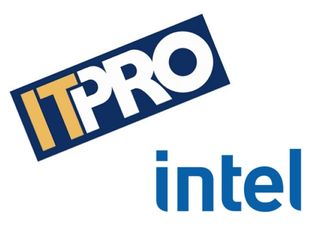IDF 2007: The low-down on 45nm
Intel will bring 45nm to the enterprise first, but applications will need to be multi-threaded to take full advantage of the architecture. Mary Branscombe gives us the lowdown on 45nm.

What 45nm chips and systems are coming?
The first 45nm chip is codenamed Penryn; there will be a version for ultra mobile devices called Silverthorne and a second generation with a new micro architecture called Nehalem which will have up to eight cores. Intel plans 15 different 45nm processors this year and another 20 in early 2008.
The current Xeon server platform, codenamed Bensley, will move to 45nm dual and quad core CPUs with the same 1333MHz front side bus, but there will also be a new server platform with a 1600MHz front side bus and generation 2 PCI Express ports. Codenamed Stoakely, this will take two 45nm quad core Harpertown processors.
When will PCs with 45nm chips be on sale?
Enterprises get 45nm first. Both Xeon 5000 server platforms will be available in the last quarter of this year in both quad core (Harpertown) and dual core (Wolfdale); the only desktop PCs to get 45nm this year will be Core 2 Extreme systems (Yorkfield) aimed at gamers and media professionals.
Single core 45nm systems for Xeon 3000 series servers, using the Garlow platform, and quad and dual core Core 2 Duo (Wolfdale) and vPro (Yorkfield) desktops will be on sale in the first quarter of 2008, as will Mobile Core 2 Duo notebooks. The next version of Centrino, codenamed Montevina, will have a 25W dual core Penryn chip in mid 2008. Silverthorne ultra mobile systems will be available in the second half of 2008 and Nehalem systems will first move into production in 2008.
Because 45nm allows for a physically smaller processor, Intel will be introducing a half-size server motherboard, the X38ML. "You can put two of these in one rack mount width and still have room for the power supply and disk drives," according to Intel vice president and director of group operations for digital enterprise Stephen Smith.
Get the ITPro. daily newsletter
Receive our latest news, industry updates, featured resources and more. Sign up today to receive our FREE report on AI cyber crime & security - newly updated for 2024.
Is 45nm better for mobile computing?
The Hafnium interface that Intel is using inside the 45nm transistors doesn't leak power as much as the current silicon equivalent, by a factor of 10, which obviously makes the processor more efficient.
The processor can also run at a wider range of speeds, according to Mooly Eden, Intel vice president and the general manager of the mobile platforms group. "We use the deep power down technology to enhance battery life," he said. "And we have dynamic acceleration technology; in some cases when we have fewer threads running on the machine I can power one core right down and run this other one faster, so that it can finish the job and go to sleep more quickly".
How much faster will Penryn be?
45nm allows for more transistors on a physically smaller chip - and for other things on the chip like extra cache. "The die size is about 25 per cent smaller, enabling [reduced] costs of manufacturing scale, but also enabling a 50 per cent increase in cache size," claims Pat Gelsinger, Intel's senior vice president and general manager of the digital enterprise group.
For servers Intel is quoting a 19 per cent improvement with the SPECint benchmark running on a 3.2Hz Harpertown system over a 3GHz Clovertown system, a 25 per cent improvement running Java and a 34 per cent jump for SPECfp, which measures floating point calculations. As Smith points out, "that measures the ability of the platform to get data from memory as much as the compute power."
Intel is also claiming a higher score on SPECfp than AMD's 2.5GHz quad core Opteron, by nearly 4 per cent.
Gelsinger also showcased the performance enhancements of a quad core Xeon 5400 with 1600MHz front side bus by running an application from Paradigm for visualising geographical information for oil and gas exploration. Together with Alistair Downie, manager of Western Hemisphere R&D for Paradigm, Gelsinger demonstrated the fruits of the seismic imaging application looking at rock bed faults rather than the actual analysis which involves the processing of terabytes of data and can takes weeks or months to run.
Will you want 45nm on the desktop?
It depends what you're going to use it for. For workstation applications Smith claims a 23 per cent speedup running multiple applications (SpecScape, SolidWorks and Fluent) with Penryn. "For simultaneous multithreading we have for the first time not only a quad core with Nehalem but one that runs two threads per core; if you have a parallelisable workload, the most efficient way to run that workload is in a multithreaded environment," he said.
For desktop systems, Intel's benchmarks for 3GHz quad core PCs running applications like photo editing and 3D editing show performance increase of only 10 per cent, but with a DiVx decoder rewritten to use SSE4 instructions the speed up is 63 per cent. The operating system can allocate different processes to different cores but this isn't using all the capabilities of the new systems.
Fewer desktop applications today are written for multithreading so we'll need new versions of software to take better advantage of the extra cores and threads directly.
Mary is a freelance business technology journalist who has written for the likes of ITPro, CIO, ZDNet, TechRepublic, The New Stack, The Register, and many other online titles, as well as national publications like the Guardian and Financial Times. She has also held editor positions at AOL’s online technology channel, PC Plus, IT Expert, and Program Now. In her career spanning more than three decades, the Oxford University-educated journalist has seen and covered the development of the technology industry through many of its most significant stages.
Mary has experience in almost all areas of technology but specialises in all things Microsoft and has written two books on Windows 8. She also has extensive expertise in consumer hardware and cloud services - mobile phones to mainframes. Aside from reporting on the latest technology news and trends, and developing whitepapers for a range of industry clients, Mary also writes short technology mysteries and publishes them through Amazon.





